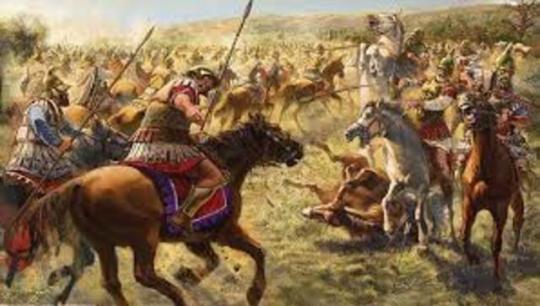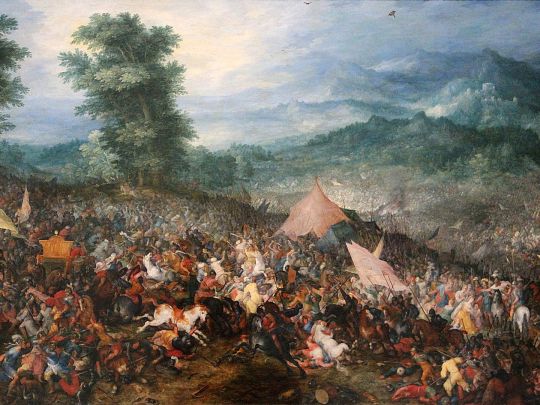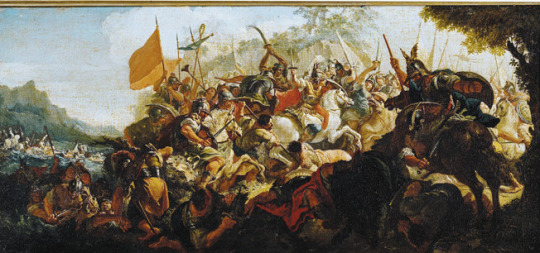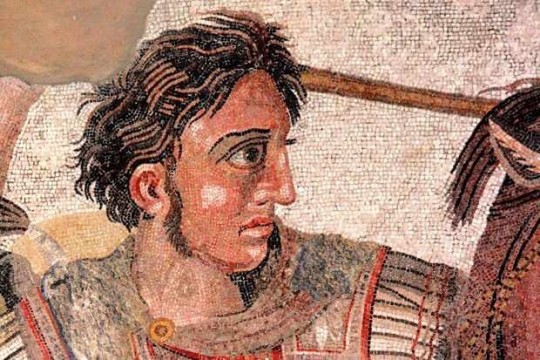This blog is for depiction of Alexander the Great's military conquests and its impact on the world. Starting at 334 BC and ending in 326 BC. Alexander never truly stops as soon as he starts in 334 and neither does his devout military.
Don't wanna be here? Send us removal request.
Text

A Legacy Left
Alexander the Great’s military conquest and acts genius were cut short by a sudden illness that led to his passing in Babylon at age 32. As a general, the world recognizes him amongst one of the best to ever live. Alexander was able to adapt his tactics to his enemies and use their weaknesses to his advantage. Through his mostly compassionate and tolerant rule, he held onto his empire successfully throughout his reign. Not to mention accounts of him having a charming and kind personality that would add to his credibility to rule an empire such as his. He created one of largest and most powerful empires of the ancient world and did it through versatility and genius. Generals to come would try to rival his conquests and military campaign in such a short span of time, but no one would come close until a more modern era of the world. After conquering the Persian Empire, ancient empires took a turn, and this signified such a momentous turning point in history. Alexander the Great will continue to be one of the greatest rulers to ever live.
Source:
Berthelemy, Jean-Simon. “Alexander Cutting the Gordian Knot,” n.d.
0 notes
Text

When: 326 BCE
Battle: Battle of Hydaspes
Summary:
The Battle of Hydaspes one of Alexander the Great’s final victories and his final great foe. As Alexander moved through India, he made an alliance with a local ruler, Taxiles of Taxila. The alliance held one request: defeat another local ruler, King Porus. After Porus refused a peaceful negotiation, Alexander began his plan for battle. This was one of his greatest victories, but also the most costly of the many victories he has had. This battle took place along the Hydaspes river during a monsoon. A monsoon that Porus believed Alexander would wait out. However, Alexander thought Porus would think this and he crossed the river during the storm. Along the way Alexander found an island which allowed for his military to rest as well as give them time to fully cross the river. Porus met Alexander on the battlefield as their armies faced off. Near the end of the fighting the Macedonians lost 1,000 men as well as Alexander’s horse. The Indians however, lost 12,000 men. In his defeat, Alexander asked Pous how he would like to be treated, in which Porus responded, “Like a king.” This reaction from his fallen foe gave Alexander respect for him, so much, that he would allow Porus to rule a portion of the Macedonian Empire as his own Kingdom.
Source:
“Master & Commander: The 5 Most Important Wins of Alexander the Great's Career.” HistoryCollection.com, June 14, 2022. https://historycollection.com/master-commander-5-important-wins-alexander-greats-career/3/.
Fontebasso, Francesco (1709-69) Primary creator: Italian Nationality: Musee des Pays de L'Ain, Bourg-en-Bresse, France Location: Giraudon Credit: oil on canvas Medium: defeated Porus at the Battle of Hydaspes in 326;
0 notes
Text

When: 327 BCE
Battle: Siege of Sogdian Rock
Summary:
The Siege of Sogdian Rock shows the beginning of Alexander’s conquest of India as well as his hand in psychological warfare. In the beginning of this siege, Alexander had captured the fortress held by Oxyartes. Oxyartes had previously sent his wife and daughters to the citadel which was high upon the cliffs of the surrounding area. The citadel was said to have enough food and supplies to hold off a long period of siege. When Alexander asked for surrender, the Sogdians refused stating that the only way the Macedonian’s would claim victory is if they grew wings and took the citadel. Later that night, Alexander gathered volunteers to scale the fortress. A lot of the soldier who had volunteered had previous experience due to the sieges performed throughout his military conquest. These soldiers were to wave cloth and linen at the top of the cliffs to signal their success. Upon this, Alexander then turned to the Sogdians, telling them to gaze upon his winged men who had reached the citadel. The Sogdians were so demoralized and defeated by this, they in turn, surrendered immediately. While meeting with the wife and daughters of Oxyartes who hid in the citadel, Alexander took a liking to his daughter, Roxana. After completing another successful siege in Bactra, Alexander would marry Roxana.
Source:
LLC, Arcadian Venture. Alexander the Great. Accessed June 29, 2022. https://alexander-the-great.org/alexanders-campaign/battle-of-the-persian-gate.
Marriage of Alexander and Roxane. Encyclopædia Britannica. Encyclopædia Britannica. Accessed June 29, 2022. https://www.britannica.com/place/ancient-Greece/Alexander-in-Egypt#/media/1/244231/14430.
0 notes
Text

When: January 330 BCE
Battle: Battle of the Persian Gate
Summary:
This battle was Alexander and his army cleaning up the last of the Achaemenid Empire and it’s few hold-outs that were left. The small portion of the Persian army was able to hold off the Macedonians from the high-ground given to them by the surrounding mountain range. The Macedonian forces were forced to walk through narrow passageways where the Persians above would drop boulders, rocks, missiles, and a range of arrows on them. The Macedonian army was forced to regroup and retreat as Alexander had suffered a sizeable loss in this ambush. Alexanders regroup proved to be prosperous as he then launched an attack from above, allowing for passage for his military below. He used the prisoners of war captured during this surprise attack to then lead his army through the mountain range and behind the Persians. This allowed for Alexander to breach the Persian defense and topple the last city in between him and the Persian capital of Persepolis. This battle is said to be the largest loss Alexander faced during Macedonia’s Persian military conquest.
Source:
LLC, Arcadian Venture. Alexander the Great. Accessed June 29, 2022. https://alexander-the-great.org/alexanders-campaign/battle-of-the-persian-gate.
Oltean, Radu. “Battle of the Granicus, 334 BCE’ by ,” 2014.
1 note
·
View note
Text

When: October 331 BCE
Battle: Battle of Guagamela
Summary:
This battle signified the final of the Persian military campaign as Alexander came face to face with Darius III once again. As Alexander set up camp, he had a team that scouted ahead, listing information on the enemy. One of his commanders suggested a night attack, but Alexander did not seem worried and was very set on waiting til dawn. This battle showed Alexander’s complete arrogance against his opponents as he supposedly even overslept the day of the attack. However, this was brought to his advantage as the Persians were tired from waiting all night for an attack, but the Macedonians were well-rested and fed. In this battle, the Macedonian’s traded places with Persians, now gaining better terrain in order to overwhelm their enemy and force a retreat. This plan had succeeded and the Persians were forced to fall back. Darius had escaped once again within the Persian retreat. However, one of the Persian military commanders, Bassus, had taken it upon himself to murder King Darius. Alexander saw this as an utter disrespect, not just for him, but for the former King of Persia. Alexander would hold a dignified funeral for Darius and then proceed to hunt down Bassus and have him executed. This defeat signalled the fall of the Achaemenid Empire.
Source:
“Master & Commander: The 5 Most Important Wins of Alexander the Great's Career.” HistoryCollection.com, June 14, 2022. https://historycollection.com/master-commander-5-important-wins-alexander-greats-career/3/.
Altdorfer , Albrecht. “The Battle of Alexander at Issus,” 1529. Alte Pinakothek. Munich, Germany.
0 notes
Text

When: October 332 BCE
Battle: Siege of Gaza
Summary:
With the increasing attack throughout the Persian Empire, next on the list was the city of Gaza. This city was known for its 60 ft tall walls surrounding it’s border and the incredible strength of these walls. As the Macedonian’s failed three times to breach the city, the same technology used in Tyre was called in, allowing for the walls to crumble fast. With the Siege of Tyre leaving Alexander in a more aggressive pace, he began to show a lack of mercy, especially for his military opponents. As the Gazan fought until the very end, Alexander order all of the men to be executed and the women and children to be sold into slavery as more evidence of his loss of compassion became evident. Batis, the arrogant general faced a vicious demise as he refused to bow to Alexander, subsequently causing his own fate to be as painful as possible. A rope would be tied through his heels, and he would be dragged through the city via chariot. The battle was quick and an efficient way to link contact from Egypt to Greece, but it helps show the steady increase of Alexander's brutality.
Source:
LLC, Arcadian Venture. Alexander the Great. Accessed June 29, 2022. https://alexander-the-great.org/alexanders-campaign/siege-of-gaza
“Master & Commander: The 5 Most Important Wins of Alexander the Great's Career.” HistoryCollection.com, June 14, 2022. https://historycollection.com/master-commander-5-important-wins-alexander-greats-career/3/.
Tempesta , Antonio. “Alexander Instructing His Soldiers, from The Deeds of Alexander the Great.” Netherlandish: Johannes Baptista Vrints, 1608.
1 note
·
View note
Text

When: January 332 BCE
Battle: Siege of Tyre
Summary:
As one of the most prosperous and successful ports as well as maritime empires in Phoenicia, Alexander set his eyes on Tyre. He would pass Tyre through his Persian conquest, but could not leave Tyre to later plot against him as they controlled the Mediterranean Sea. However, with lack of a naval fleet, Alexander looked to his engineers to form a bridge in order to bring his army to them. The approaching bridge drew alarm to the people of Tyre and the began to reinforce their walls in case of attack and also launch multiple attacks of their own. While arrows and projectiles only prolonged the attack slightly, their fire ships did the most damage to the bridge. This however, did not stop Alexander as he then began to widen the bridge as well as adding fireproofing measures to it. The seven months leading to this attack showed that landfall and immense bloodshed was inevitable, as the Macedonian army and more importantly, Alexander, to become impatient and increasingly arrogant leading into this attack. This battle was known for its brutality, a brutality that Alexander had not shown previously. The King who was known for his mercy and generosity ordered for nearly two thousand men to be executed. This rage and loss of modesty was a direct message to Darius and warning as for what was to come.
Source:
LLC, Arcadian Venture. Alexander the Great. Accessed June 29, 2022. https://alexander-the-great.org/alexanders-campaign/siege-of-tyre
Campbell, Duncan B. Ancient Siege Warfare. n.d.
1 note
·
View note
Text

When: 333 BCE
Battle: Battle of Issus
Summary:
As Alexander claimed every territory along throughout Asia Minor, this caught the attention of the Persian rulers who would not stand for this disrespect. The Battle of Issus set the stage to be a deciding factor in Alexander's rule, making it a decisive battle for who would rule Asia. Darius III took interest in the young ruler and made it his personal conquest to see him fail, sending every troop from every corner of the Persian Empire to defend Issus as he and his family also made their way to modern-day Syria. Through the advancements of both militaries, they actually passed each other on the battlefield without one another knowing. This allowed for Alexander to enter Syria and the plains of Issus. With knowledge from his intelligence that the Persian military was now behind them and still moving north, Alexander turned around to launch an attack on Persian encampments that morning. As the King’s army attacked at dawn, Darius III took off, leaving his wife, mother, and children behind, whom Alexander treated with chivalrous care. Darius retreated as his army was defeated and Alexander showed no interest in going after him as he believed that he couldn’t come back from a military defeat such as this one.
Source:
“Master & Commander: The 5 Most Important Wins of Alexander the Great's Career.” HistoryCollection.com, June 14, 2022. https://historycollection.com/master-commander-5-important-wins-alexander-greats-career/3/.
LLC, Arcadian Venture. Alexander the Great. Accessed June 29, 2022. https://alexander-the-great.org/alexanders-campaign/battle-of-issus.
Darius Marching to the Battle of Issus, Apollonio di Giovanni (workshop of), c. 1450 - c. 1455
0 notes
Text

When: 334 BCE
Battle: Siege of Halicarnassus
Summary:
As word got out about Alexander the Great’s conquest through Perisa, a majority of the Asia Minor submitted to his rule and the Macedonian form of democracy. Through the momentum of the Macedonian cavalry, the army took Ionia, which opened the door for the Siege of Halicarnassus. Due to the political turmoil that left the city vulnerable to attack, Alexander couldn’t pass up on the opportunity to add to the growing Macedonian Empire. Alexander allied with rebels within Halicarnassus and plotted to have his spies meet with them to discuss their military strategy. However, the spies were not greeted by the rebels, but attacked by the Persians in an ambush. This ambush led to a fully fledged siege led by the Macedonian cavalry. As they moved in on the city, the Persians launched attacks via catapult that almost pushed the Macedonians to retreat. The Macedonians however, continued their attack breaching the newly reinforced walls of the city. As Alexander and his army made their way through the walls, the opposing military leader, Memnon, commanded the Persian army to retreat, but not without burning the city to the ground first. Though the city was destroyed, Alexander the great now controlled the full territory of Caria, continuing his reign through Asia Minor.
Source:
LLC, Arcadian Venture. Alexander the Great. Accessed June 29, 2022. https://alexander-the-great.org/alexanders-campaign/siege-of-halicarnassus.
Fontebasso, Francesco. “The Battle of the Granicus in May 334 BC,” 1709.
0 notes
Text

When: May 334 BCE
Battle: Battle of Granicus
Summary:
The Battle of Granicus would become Alexander the Great’s first military victory as well as his battle that led closest to failure. This battle was the first of many of the invasion of the then Persian Empire that Alexander seeked to claim. Alexander rallied fellow Greeks who were to rebel against the Persian Empire and used them to his advantage: adding the Greeks to his military line up and gaining land through allied Greek territory. Alexander led a risky attack on the steep-sided river that would leave him disarmed. His fellow companions however, would launch a counterattack in order to save him and they pushed on Persian line. As they breached the Persian defense, the Macedonian phalanx pressured the gap in the defense and soon moved through, fighting any Persian soldier who got in their way as they advanced. Alexander would claim victory as the Persian military retreated. The remaining opposition of Greek mercenaries that were left behind during the Persian retreat were deemed traitors and sent to Macedonian mines to work. Alexander would then move on, starting his successful military campaign.
Source:
Matthews, R.. "Battle of Granicus." Encyclopedia Britannica, March 24, 2017. https://www.britannica.com/event/Battle-of-the-Granicus-334BCE.
Alexander the Great leading his forces against the retreating Persian army led by Darius III at the Battle of Issus in 333 BCE, detail of a mosaic from the House of the Faun, Pompeii; in the National Archaeological Museum, Naples, Italy.
0 notes